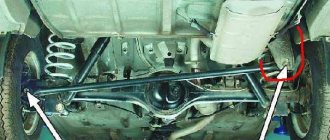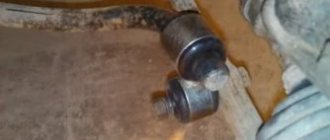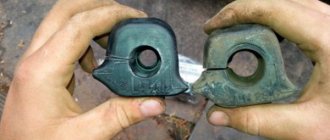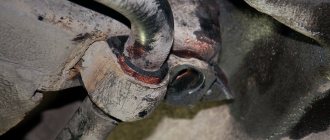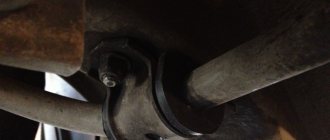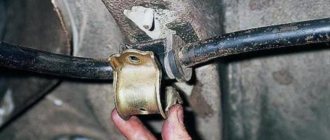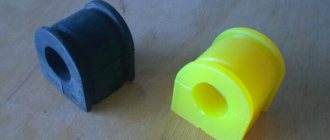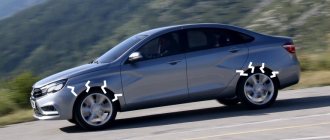Many different gaskets and rubber bushings are installed on automobile mechanisms for normal functioning or as a connecting element. But such elements wear out quite quickly due to increased intensity. As a result, play appears in them, which makes traveling by car unsafe. In addition, worn bushings can lead to more serious problems.
This also applies to bushings installed on the stabilizer. If you begin to notice noise in the car's suspension while driving, this may mean that the stabilizer bushings need to be replaced. Moreover, this applies to replacing the front and rear bushings. This will be discussed in more detail in this article.
Stabilizer design features
In the field of mechanical engineering, the stabilizer appeared along with the first cars whose maximum speed exceeded 20 km/h. Due to the large rolls that occur when turning, there was a need to install this component. The main purpose of the stabilizer is to protect the vehicle from rollover, since during a turn the load on the outer wheels increases, and on the inside, on the contrary, decreases. This causes the car to rock. The stabilizer makes it more stable on the road, preventing it from turning over.
On a note! All car suspensions are equipped with a stabilizer, not only in the front, but also in the rear. A stabilizer is not needed only if a torsion beam is installed at the rear of the car: the functions of the stabilizer will be assigned to the suspension itself.
The design of the stabilizer of many cars is a U-shaped metal rod made of spring steel. To secure the device to the body, special clamps and bushings are used to allow the stabilizer to rotate. To make the car more stable and increase the elasticity of the stabilizer, bushings are used - all impacts from various suspension elements fall on them.
Suspension diagnostics at a service center
The cost of such diagnostics varies from five hundred to a thousand rubles. Diagnostics allows you to identify suspension defects. Since this part of the car is most susceptible to wear and tear, diagnostics must be carried out promptly and in a timely manner.
You can determine that it is time to check the suspension for serviceability by an uncharacteristic knocking sound and an increase in the braking distance of the car. The vehicle's stability on the road also weakens over time. Diagnostics in service centers are carried out using high-precision equipment (play meter, lateral care tester) and provide maximum information content. After diagnosis, you will receive a special diagnostic card with the results of the work.
What are bushings and why are they needed?
The main task of bushings is to reduce the noise of the suspension when driving and attach the stabilizer to the car body. As a rule, they are made from two materials: polyurethane and rubber. The parts have high elasticity and strength, which is why there are no squeaks or knocks when the height of any of the wheels changes. In addition, it is impossible to rigidly attach the stabilizer to the body, since the distance from the attachment point to the edge of the stabilizer changes when bending.
Bushings can be made from different materials
Often, a faulty bushing can be indicated by various sounds that occur when driving and making sharp turns - squeaks, knocks, and so on. This phenomenon is associated with the loss of elasticity of the bushing, as a result of which it becomes very rigid. Dust or sand may also accumulate under this part.
Advantages and disadvantages of SPU
Despite the apparent simplicity of the design of the mechanism we are interested in (for its fastening you only need a strong support, a high-quality rubber bushing, rods, bones), it easily copes with the tasks assigned to it. It is worth mentioning here, however, that LSS reduces the travel of the independent suspension and “takes away” several other important properties from it. For this reason, a stabilizer bar is not installed on SUVs.
When driving such all-terrain vehicles equipped with all-terrain tires on bad roads, there is a noticeable loss of contact between the wheel and the road and its suspension. This negative phenomenon is caused precisely by the use of SPU. It is obvious that car designers do not intend to abandon the use of a stabilizer in these cases either. Currently, several options for modernizing SPU designed for SUVs have been developed.
For example, TRW has developed a modern system consisting of hydraulic cylinders that act as struts, a lateral acceleration sensor, a hydraulic pump and a special control unit. This system, which does not require rubber bushings, has proven to be an effective replacement for traditional LSS.
Western automakers have begun installing adaptive suspensions on their cars. These mechanisms eliminate the need for SPU, guaranteeing ideal vehicle behavior (no roll) in all driving conditions (acceleration, cornering, hard braking, etc.).
Signs of bushing wear
The design parameters of the bushing are a little similar to the parameters of a ball joint, only the bushing has one unpleasant feature - it wears out, as a result of which the part becomes faulty. It should also be noted that driving a car with damaged suspension elements is unsafe, so if you have identified a fault with the stabilizer bushing, try to replace it as soon as possible. Determining the unsuitability of the bushing for the driver will not be difficult, because when driving it will become difficult to control the vehicle.
How to bleed shock absorbers
Detailed information with step-by-step instructions can be found here. You may also be interested in an article about increasing vehicle clearance.
In most cases, wear of the stabilizer bushing is accompanied by characteristic sounds in the suspension area, which increase as the vehicle accelerates. Overcoming road irregularities (bumps, holes, pebbles on the road) makes drivers shudder from the resulting shocks in the lower part of the car. An attentive driver will immediately notice extraneous noises and minor deterioration in the car’s handling, and will also begin to find out the cause of this problem.
This is what a worn bushing looks like
To prevent the bushings and suspension from reaching such a state, it is recommended to carry out regular inspections of all structural elements. In this case, it is necessary to conduct a close diagnosis of the bushing.
What can cause stabilizer bushings to fail?
The main reason why these parts wear out is the strong impact on them during machine operation of the following factors:
- exposure to chemicals. It occurs due to its close location to the wheels of the car. During movement, various chemical compounds come into contact with the open parts of the bushings. The most dangerous of them are substances used in winter to remove ice on the road. They have a strong impact on the structure of the bushings, promoting their drying out and the appearance of cracks;
- strong mechanical impact. The quality of roads in each region differs from each other. However, even in the most favorable areas there are many trails whose quality leaves much to be desired. Accordingly, the more the car is used on roads with serious damage, the faster the strength of the parts is consumed. This happens due to the increase in friction that occurs when the suspension compensates for uneven road surfaces;
- the quality of the material from which the bushings are made. Typically, even the best rubber bushings have a relatively short service life. But most manufacturers install them on their cars. Therefore, when replacing old bushings with new ones, experts recommend using products made on the basis of polyurethane. These products have a significantly greater safety margin and will last you significantly longer.
Diagnostics
Diagnosis of stabilizer bushings consists of two steps:
- visual assessment;
- providing mechanical impact.
It is necessary to park the car on an overpass or pit to check the rubber bands. Some people use a lift for this purpose, but this can be dangerous. The fact is that diagnosing bushings involves strong tugging of the stabilizer, as a result of which the car sways and may fall. The same applies to jacks, from which the car will come off much faster than from a lift. This can lead to the most dire consequences, since the weight of the car is very large, and this entire metal structure can crush the mechanic.
Diagnostics of stabilizer bushings
The purpose of a visual assessment is to inspect the rubber bands for tears and cracks. If even one crack is found on one part, then the entire set needs to be replaced. Mechanical action requires brute force - grab the stabilizer next to the bushing that connects the part to the body, and pull it hard in all directions. During the process, knocking or squeaking noises may occur. This means the bushings need to be replaced. During the mechanical impact, do not be afraid to damage the stabilizer or the bushings themselves - they are designed for heavy loads, so your attempts to check the serviceability of the parts will not cause them any harm.
How to change stabilizer bushings?
Repair of rubber bushings is cheap and can be carried out at a service center with the help of experienced specialists. This procedure should not put a big dent in your budget. If you prefer to carry out repairs on your own or you do not have the opportunity to visit a service center in the near future, then you need to perform the following steps:
- drive the car to a pit or overpass. You can use a lift or jack, but these are less reliable and safe methods;
- loosen the wheel bolts next to which the faulty parts are located, and then remove them;
- the next step is to remove the nuts that secure the strut to the stabilizer. At the end of this procedure, disconnect the strut and stabilizer;
- Next, you should pay attention to the bracket mounting bolts. The rear ones need to be loosened and the front ones unscrewed;
- The next step is to remove dirt and clean the installation area for the new stabilizer bushings. Carry out this procedure carefully, because the service life of the new bushings will depend on the quality of its implementation;
- Lubricate the bushings on the inside. To do this, you can use silicone spray or regular soap solution;
- insert new bushings into their mounting location and return the vehicle to its original condition.
Note! Some car models, due to their design features, require removal of the crankcase protection.
The most difficult part is the process of replacing the front bushings of the vehicle. During its implementation, additional difficulties may arise due to the design features.
What will you need for replacement?
You won't need many tools to do this job, but you will still need to prepare them ahead of time.
To replace stabilizer bushings you need:
- jack;
- ruler or caliper;
- special extension for the key;
- ratchet wrench;
- ring wrenches, one for 13, and the other for 10;
- extended socket heads or regular ones (14,13).
It is worth noting that this is only a basic set of tools; in fact, others may be needed. This is due to the need to unscrew the fastening nuts when removing the stabilizer. This is the whole problem, because with a regular wrench you will not be able to unscrew the fastening nuts (during operation they become stuck to the part). In this case, many resort to emergency measures - using a hacksaw or grinder. In the process of loosening the nuts, the stabilizer links may be damaged, so replacing the rubber bands alone will not do.
Let's sum it up
As you can see, the rear stabilizer bushing or the front stabilizer bushing is a simple element both in terms of design and replacement. At the same time, the bushing of the stabilizer link and the bushing of the stabilizer itself are different, so it is important not to confuse these elements when selecting the necessary spare parts.
The vehicle suspension is one of the most important parts, subject to heavy loads and taking on all the impacts of a rough road. Thanks to its operation, the driver can feel comfortable and not be afraid that while driving the situation may get out of control. However, due to heavy loads, especially when driving on bad roads, which is not uncommon in the Russian Federation, its parts often fail. The most common problem is broken stabilizer bushings. Let's take a closer look at why this happens and how the stabilizer bushings are replaced.
Replacing front bushings
This procedure can be performed in two ways: jack up one side of the car or two. The second method is considered more labor-intensive, but many motorists prefer it. In addition, with both sides of the machine raised, installation and removal of the bushings will be much easier. The main thing is safety precautions and following the step-by-step instructions given below.
Step 1: First, buy replacement parts. You can take the original or an analogue - it depends on your preferences and financial capabilities. Although even if you choose the original, you will have to pay no more than 400 rubles for the parts.
Try not to save money when choosing new bushings
Step 2. Having installed the wheel chocks, jack up the car. Then unscrew the bushing bracket mounting bolt. To do this, you will need a 12mm wrench. If the bolt does not turn, then treat it with WD-40 or, as this product is popularly called, “Vedeshka”. After 5-10 minutes, the fastening element can be easily unscrewed.
If the bolt is very rusty, then you will have to use a grinder
Step 3. After the fastening bolts are unscrewed, bend the retaining bracket slightly upward. It is very difficult to do this with bare hands, so use a screwdriver and slightly pry the outer part of the bracket with it.
Bend the fixing bracket
Step 4: Carefully remove the bushing. There is no need to use any tools for this; the bushing can be easily removed as is. After removal, inspect the part for damage, signs of wear, or cracks.
Removing the stabilizer bushing
Step 5: Place the new bushing in place and lower the retaining bracket onto it. Before doing this, it is advisable to treat the surface of the bushing with a small amount of graphite lubricant so that the bracket is installed on the rubber band without problems. After this, tighten the mounting bolt, being careful not to strip the thread. Otherwise, you will have a few more worries.
Place the bushing in its place
Replacement and repair of SPU - when is it required and how is it done?
The anti-roll bar should be repaired immediately if its elements are noticeably deformed. If you notice that the bar is slightly bent, it is recommended that you carefully align it. However, if there is significant deformation, the solution is to replace immediately.
In addition, repair or replacement of the SPU is carried out when the mechanism cushions lose elasticity (severe wear) and are poorly close to the stand. To repair or install new blocks, do the following: Unscrew the mounting bolts from the clamp holding the blocks; Insert a screwdriver under the hook, gently push it down and remove it.
After completing these steps, you can remove the airbag (the right airbag must be taken outside to disassemble the car, the left one - towards the center) and repaired or installed a new one. Removing and replacing SPU spacers also takes very little time. We carry out this process with a 14 mm wrench according to the following scheme:
- Remove the nut on the boom holding the mounting bolt;
- Remove the bushing (top);
- Pull out the rocker arm suspension bolt (direction down), then remove two bushings - rubber and special gasket.
In the same way, disassemble the second shelf, replace or repair them, and then reassemble in reverse order. If we want to disassemble the bar, after removing the struts we remove the pillow supports (we described this operation earlier), then the bar moves out of place without any problems.
The suspension of any car is always the first to absorb the impact of road irregularities. Depending on the design and settings, the suspension components do their job: absorb shock loads arising from surface unevenness, and provide controllability and stability at high speeds when cornering, as well as sudden changes in trajectory (“snake”, avoiding obstacles). Not only comfort, but also the safety of the driver and passengers depends on the performance of the suspension. Each suspension element plays its role. Handles and levers support the wheel in a given plane, providing free rotation in two planes (when turning).
Replacing rear bushings
The rear stabilizer is secured using two bushings made of rubber. As a rule, during the operation of the car, these parts lose their strength and elasticity, as a result of which they are no longer able to perform their main functions. As a result, the rear suspension begins to knock when driving. If you hear characteristic sounds, it means you need to replace the rear bushings. Just like when replacing front bushings, you need to jack up the car. It is advisable to lift two sides at once - right and left. Now get to work.
Step 1. Get new rubber bands first. In this case, they come complete with a special lubricant, which extends the service life of the parts and facilitates the replacement process.
Stabilizer bushings with lubricant
Step 2. Clean the surface of the stabilizer and fastening element from dust. To do this, use coarse sandpaper or a stiff brush. Then spray some WD-40 on the bolt to make it come out easier.
Spray the wedge onto the fastening bolt
Step 3. Unscrew the mounting bolt by 14, and then lightly press the bracket with pliers so that you can then remove the part. As you can see, the processes for replacing the front and rear hubs are not much different from each other, with the possible exception of the screw being removed.
Removing the bushing bracket
Step 4. Lubricate the stabilizer with the liquid from the kit, after which you can install a new bushing. Do not mix up the sides of the part; install it with the same side as before. Otherwise, you risk significantly reducing the life of a completely new part.
Lubricate the stabilizer and bushing before installation
Step 5. Carefully install the stabilizer bracket into place and secure it with the bolt. In this case, you need to be careful not to damage the fastener or the bracket itself. Now lower the back of the car and drive it to check your work.
Reinstall the bushing. Gently tighten the mounting bolt.
Modern car suspension
Design and operation of the suspension
The main task of the suspension is to provide an elastic connection between the body and the wheels. Thus, the suspension softens the shocks and jumps that occur when the car moves on an uneven road or its absence. The smooth ride of a car directly depends on the suspension.
The suspension serves as a kind of shock absorber, absorbing the energy that occurs when hitting bumps or falling into holes and ruts. However, it does not guarantee complete smoothness of movement and wears out greatly with frequent movement over uneven surfaces.
Pendants are divided into the following types:
- McPherson;
- double lever;
- multi-link;
- adaptive;
- "De Dion"
- rear dependent;
- rear semi-independent;
- pickups and SUVs;
- trucks.
McPherson type suspension
The McPherson type suspension is one of the oldest. It was developed by the talented engineer Earl McPherson in 1960. Consists of a stabilizer bar, a lever and a block. A serious disadvantage of the suspension is the change in the wheel camber angle, but it is very popular due to its availability and reliability.
Double wishbone suspension
The double wishbone suspension is one of the most advanced designs. This is a suspension with two arms of different lengths (the upper one is short and the lower one is long). This design allows the car to maintain stability on the road and ensures the durability of the tires. Each wheel accepts its own obstacle independently and does not transfer the load to the other wheels.
Multi-link suspension
The multi-link suspension was developed not so long ago and is an even more advanced design. It is a set of many levers, silent blocks and hinges. All these components are designed to absorb shocks and strong shocks while driving. The noise level from the wheels in the cabin is also reduced. The suspension has separate lateral and longitudinal adjustments. The wheels are independent of each other. The design is ideal for all-wheel drive vehicles.
The cost of a multi-link suspension remained quite high for some time, but now even golf car drivers can afford it.
Adaptive suspension
The adaptive suspension is very interesting from a design point of view. For a long time it was primitive and weighed a lot, but now it has been greatly modernized. Thanks to this, it allows maximum body roll and wave swing at high speed and allows you to automatically adapt to any type of road surface. The adaptive suspension includes: adjustable anti-roll bars, active shock absorber struts, a chassis control unit and electronic sensors that record road irregularities and other parameters.
"De Dion"
“De Dion” is named after its French creator. The main function of such a suspension is to reduce the load on the rear axle of the car by separating the final drive housing. In this case, the crankcase rests on the body. This design allows you to make the suspension dependent or independent. But there are also disadvantages. With a sharp start, the car body can put a lot of pressure on the rear axle.
Rear dependent suspension
The rear dependent suspension is a real classic option, as it was used on many old VAZ cars. The suspension is based on cylindrical coil springs, which are elastic elements. The rear axle beam “hangs” on springs and is fixed to the body by means of four longitudinal arms. The reactive crossbar acts as a roll absorber and has a positive effect on handling. But don’t expect comfort and smoothness from this suspension, since the rear axle weighs a lot.
Semi-independent rear suspension
Semi-independent rear suspension is most often used in vehicles with all-wheel drive. Its main elements are two longitudinal arms attached in the center to the cross member. This suspension weighs little and does not require any special maintenance or major repairs. But such a suspension can no longer be installed on rear-wheel drive cars.
Other types of pendants
Pickup trucks and SUVs have different suspensions. There are completely dependent and completely independent varieties of such suspension. Dependent suspensions are used less frequently, since the rigid connection of the wheels to each other leads to large loads, reduced controllability and other troubles when driving off-road. Much more popular is the spring system, which is more soft (
Benefits of timely replacement
Every driver can cope with replacing bushings on his car, because this process is not a very complicated repair. You can do everything yourself, but if you don’t have the time or desire, then it is advisable to seek help from specialists. This will protect the stabilizer bar links from premature wear.
Driving on poor-quality road surfaces will fade into the background if you have previously installed new bushings. And in general, installed new bushings mean the absence of difficulties and problems when moving, as well as comfort and safety.
avtoexperts.ru
Before dealing with the topic of what a stabilizer bushing is, it wouldn’t hurt to refresh your memory about the stabilizers themselves, what are they for? The main task of this part is to keep the car as parallel to the road as possible. Despite various risks, for example, turns, braking, which cause both lateral and longitudinal rolls. The stabilizer must cope with them.
In the photo: stabilizer bushings for Honda Civic 5D
Structurally, the stabilizer is a conventional rod, the task of which is to connect the subframe with the wheel mount. When it comes to the front suspension, it makes more sense to say that the attachment occurs with the suspension arm, since MacPherson struts are often installed at the front.
Stabilizer bushing - yellow
At the slightest roll, the ends of the stabilizers begin to move, thereby reducing the roll. The movement occurs along the bushings, which will be discussed. The purpose of the latter is to allow the stabilizer to twist in different directions. That is why they secure it with bushings. Over time, the bushings wear out, causing play to occur, which will lead to improper operation of the entire mechanism. The so-called “freedom of the part” increases, then, by and large, the presence of a stabilizer plays no role. Because, similarly to its absence, roll increases due to large strokes and rotation, controllability is lost and this is felt mostly in turns.
Suspension diagram
Kinds
There are several types of bushings:
• Rubber bushings.
• Polyurethane. Similar to the previous ones, except for the production material.
Rubber left, right polyurethane stabilizer bushing
Recently, motorists have given preference to polyurethane bushings due to their high performance characteristics. As a rule, they “walk” longer. But this is also individual, depending on how you drive.
Also, you should not lose sight of the nuance that almost every model has its own size and configuration of bushings, which is why special attention needs to be paid to the selection and selection for a specific model. This issue is most acute for foreign cars.
What resource?
This question is quite individual; as such, no manufacturer can give exact “mileages”. It all depends on the specific operating conditions; keep in mind that bad roads, driving style, all of this affects the “life” of the bushing, and the stabilizer mechanism as a whole.
By the way, bushings are considered the most problematic area in the suspension on the Lada Vesta. A creaking noise begins almost immediately from the factory, and a knocking sound is often added to it while driving over bumps. The problem is that they use low-quality material for manufacturing, which is why the resource of the original bushings on Vesta is very small. It’s all very simple to treat; you need to select analogues from other models. For example, it is known that bushings from Toyota Corollas, Avensis and KIA Rio fit perfectly and do not cause problems for West owners.
Stabilizer bushings for Lada Vesta from Kia Rio. Bushing article - Hyundai/Kia 54812-1G100, bracket - 54814-1G000
Judging by the reviews of drivers, bushings from German brands, which are often installed on “Germans” from the factory, performed well. For example, original parts can often last more than 150,000 km. At the same time, when it comes to analogues from China, the resource is reduced several times.
In general, it is generally accepted among motorists that the average “mileage” for a rubber bushing is 70,000 km; more advanced polyurethane bushings “run” 100,000 km. Some manufacturers even recommend carrying out a scheduled replacement after 30,000 km in order to avoid “surprises”. But, as already mentioned, everything is individual, you need to take into account all the operating features.
It is also worth clarifying this nuance; the life of the bushings is greatly influenced by the state of the thrust (stab) itself . For example, if there is a hole in the place where the bushing is attached, then the part will definitely not last the stated period and will not fully cope with the task. As a rule, after replacing the original bushings, owners observe a small amount of metal wear, somewhere around 1.5 mm. With each replacement of the bushings, the output will only increase, so in case of severe wear, it is wiser to replace the entire part so that, in general, the operation of this mechanism will be useful.
Signs of trouble
The following signs may indicate that something is wrong with the suspension. And one of the places that is worth checking is the stabilizer. So:
• Steering wheel wobble appears.
• There is a slight play when turning the steering wheel.
• The car began to “yaw” when moving.
• When turning, distinct clicks are heard from the wheels.
• The car drives in one direction.
• Vibration is felt.
How to replace?
The issue of replacement for some cars is purely individual, because depending on the model, the fastenings may differ. For example, to replace the bushings on the Mazda 6 and 5 at the front, you will also have to remove the steering rods to get to the brackets securing the rod itself. But, in general, you can draw up a small work plan. So:
• Lift the car on a lift or drive it into a pit for convenience.
• Before unscrewing the bolts, we recommend treating them with a special agent so that they can be easily unscrewed, for example, WD-40.
Replacing stabilizer bushings using the example of Volkswagen Polo sedan
Keep in mind that the bolts may not budge even after this. Then the “grinder” comes into play. But first take care to remove the fuel hoses from the “dangerous” area. Cut off the "ears" of the staples to "free" the bar.
• After unscrewing the brackets (clamps), we move the stabilizer itself away from the subframe to make it easier to remove the bushing. Use a crowbar.
• Pull off the old bushing.
Photo — Drive2.ru
• We put on a new part.
Replaced the bushing
• Next, return the clamp to its place.
Please note that in most cases, the clamp fits extremely poorly on the new bushing, so try to position it as evenly as possible and minimize friction (use lubricant).
• We tighten the clamp with a bolt. By the way, we recommend that you pre-treat the bolt and nut with lubricant so that in the future there will be no problems with unscrewing it.
By the way, this is an important nuance during replacement. You need to change both bushings at once, that is, do not leave the old part on the right side, but, for example, install a new one on the left side. There should be new bushings on both sides.
Features of the problem for popular models
Statistics show that owners of such car models as Renault Megane, Skoda Rapid, Volkswagen Polo, Lada Vesta (and other representatives of the domestic automobile industry) are faced with problems associated with stabilizer bushings. Let's look at the features of specific car models, as well as recommendations for replacement.
Table. Description of the problem for some models
| Model | Description of the problem |
| Lada Vesta | Often, it is the structure of the suspension of a given car that is the main cause of problems with bushings. Vesta is famous for its large travel of stabilizer struts, which can cause unpleasant sounds when moving. Many car owners lower the seating position of their car to solve this problem. You can also use a special silicone-based lubricant. |
| Volkswagen Polo | There is one proven method for eliminating squeaks - install a small piece of an old timing belt between the stabilizer bushing and the car body. The replacement of bushings itself is no different from that indicated in the instructions above. |
| Skoda Rapid | As practice shows, the best way to get rid of squeaks is to install original VAG rubber bands. Also, many motorists use repair bushings that differ from the usual sizes (repair bushings are 1 mm smaller). As an alternative, you can install rubber bands from other models of this manufacturer, for example, from the Skoda Fabia. |
| Renault Megane | The process of replacing the bushing is no different from other models, but before installing a new rubber band, it and the seat must be treated with a lubricant, which will not harm the parts later. You can use shampoo or soap for this purpose. Depending on the modification, Renault Megane can be equipped with reinforced or conventional suspension, therefore, the dimensions of the bushings and the stabilizer itself may differ. Please keep this in mind when purchasing replacement parts. |
| Mercedes Sprinter | Before purchasing bushings, you must first measure the diameter of the stabilizer, since their dimensions may vary depending on the modification. To do this, use a caliper. Many experts recommend buying special rubber bands for your car, equipped with anthers to protect against dust and water. To treat the surface of parts, it is necessary to use silicone-based products that will not corrode the rubber. Such products include “MOLYKOTE PG-54”, “Litol-24” and others. |
Why the Tochka Opory brand?
We recommend using polyurethane bushings from the Tochka Opory brand as new car suspension elements. Spare parts made of polyurethane prevent premature wear of the vehicle's chassis. In addition, polyurethane products, due to their elasticity, resistance to natural factors and unpretentiousness, are ideal for use in the climatic conditions of Russia.
Most rubber bushings lose their properties due to exposure to adverse factors. Polyurethane parts will maintain performance even at low temperatures. At the same time, vehicle handling will be better, and the frequency of replacing suspension elements will be reduced.
In our online store you can buy stabilizer bushings made of polyurethane from the Tochka Opory brand: we always have a large selection of products from this brand in stock. Experienced managers will help you with choosing a product in the IXORA store.
| Manufacturer | Detail number | Part name | Applicability* |
| TOCHKA OPORY | 3021414 | FRONT SUSPENSION BUSH, STABILIZER LINK MITSUBISHI | MITSUBISHI COLT Z2 (2002.10 - ) PAJERO MINI H53A, H |
| TOCHKA OPORY | 1011041 | BUSHING STABILIZER, FRONT SUSPENSION TOYOTA, ID = 22 MM | TOYOTA AVENSIS AZT250, AZT255 (2003.07 - ) |
| TOCHKA OPORY | 101897 | BUSHING STABILIZER, REAR SUSPENSION TOYOTA | TOYOTA AVENSIS AZT250.. 251…SED (2006.06 - ) WG..LI (2003.07 -) |
| TOCHKA OPORY | 101755 | BUSHING STABILIZER, FRONT SUSPENSION TOYOTA, ID = 23 MM | TOYOTA CAMRY ACV30 |
| TOCHKA OPORY | 101040 | BUSHING STABILIZER, REAR SUSPENSION TOYOTA | TOYOTA COROLLA AE101 (1997.05 - 2000.08) SPRINTER AE101 GT |
| TOCHKA OPORY | 9012176 | STABILIZER BUSHING, FRONT SUSPENSION SUZUKI, ID = 25.5 MM | SUZUKI GRAND VITARA |
| TOCHKA OPORY | 26012665 | STABILIZER BUSH, REAR SUSPENSION GREAT WALL, ID = 18.3 MM | GREAT WALL HOVER SAFE |
| TOCHKA OPORY | 101758 | BUSHING STABILIZER, FRONT SUSPENSION TOYOTA | TOYOTA COROLLA FIELDER COROLLA RUNX ALLEX NZE124, ZZE124 C |
| TOCHKA OPORY | 8011034 | BUSHING STABILIZER, FRONT SUSPENSION SUBARU | SUBARU FORESTER SH5, SH9, SHJ (2007.09 - ) LEGACY B4 BL5, B |
| TOCHKA OPORY | 8011643 | BUSHING STABILIZER, REAR SUSPENSION SUBARU, ID = 1 | SUBARU IMPREZA (2008.07 - ) FORESTER (2007.09 - ) |
| TOCHKA OPORY | 12011506 | STABILIZER BUSH, FRONT SUSPENSION HYUNDAI, ID = 18.5 MM | HYUNDAI ACCENT VERNA (1999 - ) |
| TOCHKA OPORY | 3011213 | BUSHING STABILIZER, FRONT SUSPENSION MITSUBISHI | MITSUBISHI LANCER MIRAGE ASTI CS5A, CS5W AIRTREK CU4W |
| TOCHKA OPORY | 4012198 | STABILIZER BUSH, REAR SUSPENSION MAZDA, ID = 17.5 MM | MAZDA CX7 ER (2006 - ) |
| TOCHKA OPORY | 17032072 | SHOCK ABSORBER BUSHING, REAR SUSPENSION VAZ, MOSKVICH, ID = 15.5 MM | VAZ 2101, MOSKVICH 2140 |
| TOCHKA OPORY | 202658 | FRONT AND REAR SUSPENSION BUSHING, STABILIZER LINK, CONE NISSAN, ID = 10 MM | NISSAN SENTRA B1 |
| TOCHKA OPORY | 12012703 | BUSHING STABILIZER, FRONT SUSPENSION KIA | KIA MENTOR (HB) I, II (1997 - 2004), KIA CARENS (1999 - 2002) |
| TOCHKA OPORY | 301886 | BUSHING STABILIZER, FRONT SUSPENSION MITSUBISHI | MITSUBISHI PAJERO V64W, V65W, V68W, V73W, V74W, V75W, V78W |
| TOCHKA OPORY | 9011037 | BUSHING STABILIZER, FRONT SUSPENSION SUZUKI | SUZUKI ESCUDO TD54W (2005.05 - ) TA74W (2006.06 - ) TD94W |
| TOCHKA OPORY | 12012564 | STABILIZER BUSH, REAR SUSPENSION HYUNDAI, ID = 16.5 | HYUNDAI I30 I30CW (2008 - ) ELANTRA (2006 - ) |
| TOCHKA OPORY | 3011717 | BUSHING STABILIZER, FRONT SUSPENSION MITSUBISHI | MITSUBISHI COLT CABRIOLET Z36A, Z37A REGION EUROPE COLT Z31A |
* Please check the applicability of parts specifically for your car with our managers by phone (calls within Russia are free).
Need for replacement
Stabilizer bushings are among the parts that are subject to the greatest dynamic loads. They require regular replacement, depending on the maintenance regulations adopted by various car manufacturers and models. The maximum mileage before replacing the rear and front bushings is usually from 15,000 to 30,000 km. Considering the state of our roads, it is recommended to replace them based on wear and tear.
Untimely replacement can lead to the formation of a roll in the car's stabilizer, and this, in turn, increases the risk of the car tipping over at speed. The complete set must be replaced, regardless of the difference in external signs of wear. The cost of such a repair service at a service station is often overpriced, given the ease of replacement for most car models, so it is advisable to replace the front and rear bushings yourself.
How do front and rear anti-roll bars work?
The design of the UAS system is such that it cannot withstand angular, longitudinal and vertical vibrations of the vehicle suspension. When it comes to leveling a passenger car with the road surface, front and rear anti-roll bars do a great job. Their operating principle is based on the precise redistribution of the incoming axial load between the suspension elements.
During transverse angular vibrations (lateral roll) of the vehicle, the anti-roll bars move in opposite directions. In this case, one bar is lowered and the other is raised. At the same time, the sleeves allow the central part of the SPU to be twisted. The resistance of the described element increases with increasing body roll, making the car lined up on the road. Tie rods (bones) also provide better traction when cornering.
The rear (or front) anti-roll bar performs its function better the stiffer its design. This hardness depends on:
- jack geometry;
- the shape of the mechanism and its correspondence to the lower “bends”
- properties of the metal used in the production of GP.
A car with rigid front and rear stabilizers easily overcomes the sharpest turns (and the driver does not even feel the roll when cornering). New possibilities open up for car designers as they can install different degrees of IS system stiffness on the rear and front axles. Installing a stabilizer of one or another rigidity allows you to achieve a certain balance in vehicle control.
Diagnostics
Knocking of the stabilizers is a guaranteed sign of the need to immediately replace the bushings. In addition, squeaks may appear, especially when it gets colder, when the rubber loses its elasticity.
To determine the need for replacement, it may be necessary to remove the crankcase protection. To check the source of vibration, place your hands on the stabilizer link and directly on the mounting bracket. The partner must press firmly on the hood of the car several times. If vibrations are felt on the brackets, which are transmitted to the rack, it is necessary to install a new set, even if no play was noticed when inspecting the seats on the stabilizer.
If the hole inside the bushing has taken the shape of an ellipse, cracks are visible on the surface, and the material has hardened, immediate replacement is necessary. Continued operation of the vehicle will significantly reduce the service life of the stabilizer struts.
Sequence of work
- The car is securely fixed when jacked up.
- The wheels are unscrewed and removed. There is an engine protection shield in the right wheel arch. Its fastenings are unscrewed and the shield is removed.
- Most of the fasteners under the bottom are pretty acidic, so to speed up the process of replacing stabilizer bushings, they need to be thoroughly treated with a WD 40 solution, which removes corrosion.
- Using an open-end wrench, we fix the finger on the left post. It is slightly hidden from direct access, so you need to find the grooves almost by touch.
- We throw a spanner, preferably a ratchet, onto the nut that secures the shock absorber. Unscrew both fasteners.
- Having freed the stabilizer struts from their fastenings, we disconnect them from the shock absorber strut.
- We install a jack under the left rear part of the subframe. With its help, the subframe is fixed so that when the fasteners are removed, it does not suddenly jump off the studs. A metal plate of considerable size must be placed under the supporting head of the jack so as not to deform the subframe.
- Smoothly lower the jack a few centimeters from the body. Thanks to this, the subframe also lowers slightly, opening access to the bushings.
- A pipe is inserted into the resulting gap, and the subframe is further pressed down. A stopper is inserted into the resulting gap. A 27mm head is suitable; when installing it between the body and the subframe washer, it is better to use pliers. This will save your hand from injury if the pipe slips off the subframe washer.
- We generously water the bracket fastenings with WD-40. We unscrew the bolts gradually, without pressing too much.
Removing the lever
Removing the front suspension arm of a Ford Focus 2 is not difficult, but it will be easier to do this work in the inspection pit.
So, the car is driven into the pit. On the side from which the silent blocks will be removed and replaced, the car is jacked up and the wheel is removed.
Next, work is carried out under the car. To gain access to the lever, you will need to remove the crankcase protection.
We see the detachment of the silent block.
Having removed the protection, you can begin to dismantle the lever. To do this, you need to unscrew the nut securing the ball joint of the lever to the hub.
Then, using a ball joint remover, it is released from its seat in the hub.
Next, the bolted connections securing the lever to the subframe are unscrewed.
There are three such bolted connections.
This is where the silent blocks are located. After removing the mounting bolts, it is removed.
Let's look at the silent block.
And we see that it needs to be changed.
The same picture is on the left lever.
Subsequent work is carried out on the removed lever.
Mitsubishi ASX Club
Since the internal size of the bushing was reduced from the outside, the bushing when put on the amplifier became larger, but the covers are tensioned without any problems. We tighten the cover bolts with our hands and tighten them a little. A little. Then we screw the eggs back on, put on the wheels and remove the car from the trestles (stands). Then we tighten the cover bolts and wheel nuts. New bushings on the car, left and right. View from above.
As you can see, when the covers were tightened, the new bushings opened up more than the original ones, apparently due to a change in size. The stops on the stabilizer seem to be rubber, so they should not knock even with broken bushings. I screwed up and forgot to take photos of the new bushings on the car, side view. A test drive showed that there seemed to be less knocking, but we couldn’t get strong knocking noises. However, I have nothing done to the front struts. I unscrewed the rack, looked at the mating plane - I couldn’t find any “filled” places on the metal. And I couldn’t find any places where it could knock. True, I didn’t unscrew the strut from the steering knuckle for fear that there might be a camber adjustment in this place. I put this question aside for later. I'll go with new bushings and listen
